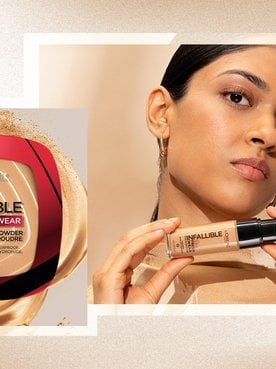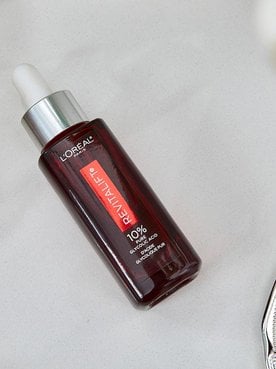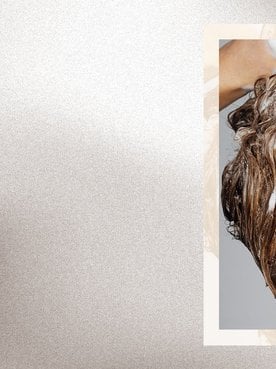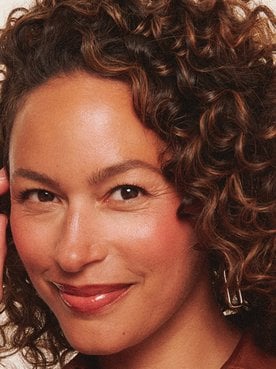You’re probably aware that certain haircare habits, like bleaching, coloring, or heat-styling your strands, can lead to damaged hair. Experts often recommend avoiding these habits to protect your hair, but that isn’t always realistic: sometimes, you simply want to treat yourself to a blowout or experiment with a new hue (as you should). Knowing what damaged hair looks like helps ensure you’re able to give your mane the TLC it deserves when it’s in less-than-perfect shape.
If you’re unsure how to tell if your hair is damaged, keep reading. Here, we’re sharing five common indicators of hair damage to look out for and offering some tips on preventing (or at least, minimizing the risk of) damage when you blow dry, bleach, or otherwise manipulate your mane.
5 Signs Of Damaged Hair
Because so many different things can cause hair damage, it can manifest in many ways. Some of the most common include dryness, breakage, frizz, split ends, and roughness, plus general unmanageability.
1. Dryness
Dryness one of the first signs that your mane is experiencing damage. When hair is damaged, the cuticle lifts, which allows moisture to escape. Over time, this can result in dehydrated strands that feel brittle, rough, or straw-like.
Keep in mind, however, that dryness isn’t always indicative of damage. Some people have a naturally dry hair type, even when their hair is in good shape. Using moisturizing products and deep conditioning treatments can help make your strands feel softer, silkier, and more hydrated.
2. Excessive breakage
Hair shedding is normal—in fact, the average person loses between 50 and 100 strands of hair per day. If you notice a sudden uptick in hair fall and breakage, however, you may be dealing with damage. Damaged hair is often brittle, and this brittleness leaves it susceptible to breakage from even simple haircare habits like brushing and styling.
3. Unusual frizz
If your silky smooth strands are suddenly frizzier than ever, damage may be to blame. When your hair cuticle is damaged, your strands have difficulty managing moisture levels, which can lead to frizz even without humidity. Frizz can also be indicative of excessive breakage.
4. Split ends
Nearly everybody has a few split ends, but if your mane is full of splitting strands, you’re likely facing damage. It’s important to care for your hair gently when you spot split ends, as friction (like from washing or brushing your hair) can make the problem worse.
5. Tangled hair
You may expect a head full of tangles after a night of tossing and turning, but damage may be the culprit if your hair is regularly tangled, matted, or challenging to manage. Split ends, broken strands, and roughed-up hair cuticles can get easily caught on other strands, creating knots that seemingly pop out of thin air.
How To Fix Damaged Hair
Dealing with damaged hair can do a number on your self-esteem, but fortunately, there are several things you can do to help restore your mane to its former glory, including switching out your shampoo and conditioner, getting a haircut, and using hair bonding treatments. For a full rundown on the different things you can do to restore your strands, check out our article Hair SOS: 11 Ways To Fix Your Damaged Hair.
If you’ve implemented our suggestions and still don’t see any improvement, it may be time to schedule an appointment with a trusted stylist. They can help you assess the damage, determine the cause, and help create a plan to address it.
How To Help Prevent Hair Damage
We love knowing how to fix a problem, but what we love even more is learning how to prevent that problem from happening in the first place. Much like life, it’s a lot easier to prevent hair damage than try to undo the damage already done. Below, we’re sharing six simple tips to help you prevent hair damage before it happens for healthy, shiny hair all year long.
1. Overhaul your haircare routine
The shampoo and conditioner you use can significantly affect the look and feel of your hair. That’s why it’s so important to invest in products that help support strong, healthy hair. We love L’Oréal Paris EverPure Sulfate Free Bond Repair Shampoo with Citric Acid and L'Oréal Paris EverPure Sulfate Free Bond Repair Conditioner with Citric Acid. This bond-repairing duo penetrates inside the hair fiber to rebuild weak hair bonds, promoting stronger, smoother hair.

Shop the Products
2. Try a hair treatment
While the right shampoo and conditioner can help prevent hair damage, we recommend adding a hair treatment to your routine if you want your hair to look and feel its best. Try L’Oréal Paris EverPure Bond Strengthening Pre-Shampoo Treatment. The pre-shampoo treatment contains a 10% bonding care complex and helps reduce breakage and repair hair in just one use.
Shop the Product
3. Maintain a consistent haircut schedule
When your stylist suggests you return to the salon for a trim every eight to 12 weeks, they’re not just trying to make a buck. Maintaining a regular trim appointment is the best way to keep split ends at bay, which can help forestall damage (or prevent it from getting worse). It also allows your stylist to assess the health of your hair regularly so they can make recommendations that suit your needs.
4. Cut back on heat styling
It’s no secret that heat styling can wreak havoc on your hair. As much as we love the sleek and bouncy styles we achieve with our hot tools, heat styling shouldn’t be an everyday thing. Try some of our favorite heatless curl styling hacks to get all the style with no damage.
5. Use a heat protectant
Cutting back on heat styling doesn’t mean you must give it up completely. When you do decide to style your hair with a hot tool, be sure to prep your strands with a heat protectant like L’Oréal Paris Elvive Dream Lengths Heat Slayer Leave In, which protects against heat damage up to 450oF.
Shop the Product
6. Treat your hair with care
Being gentle with your hair can go a long way toward minimizing damage. Detangle gently, opt for tension-free hairstyles when possible, and opt for silk or satin scrunchies to help reduce friction when you put your hair up.
Next Up: How To Remove Buildup With a Scalp Care Routine
Photo Courtesy of L'Oréal Paris







